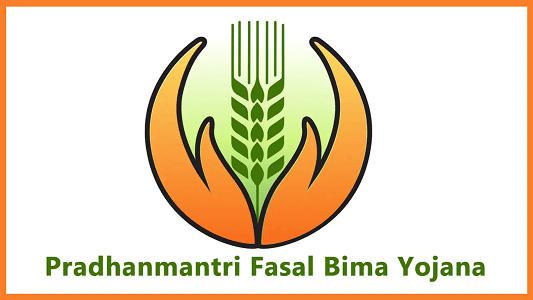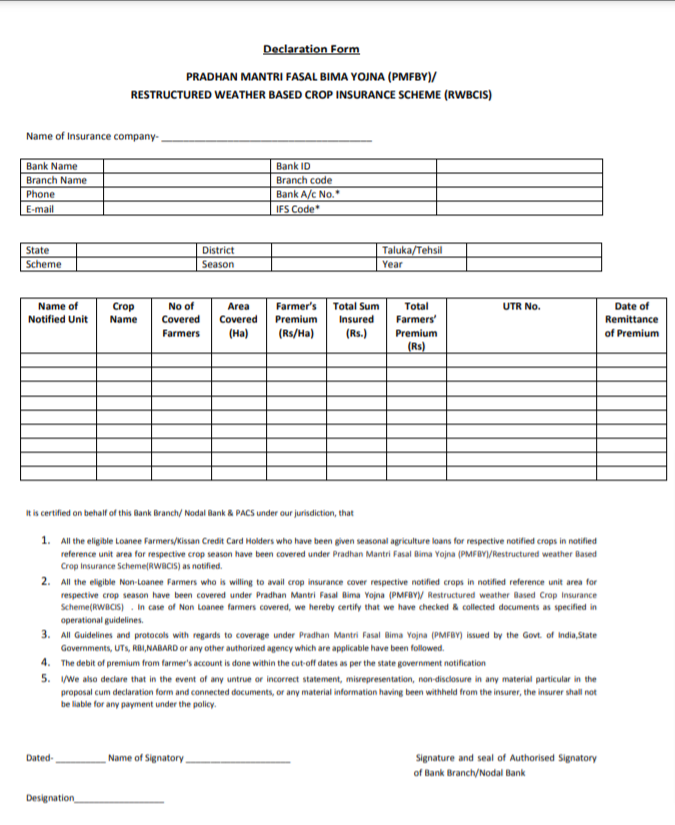This content has been archived. It may no longer be relevant
Pradhan Mantri Fasal Bima Yojana (PMFBY) was launched by Prime Minister Narendra Modi on 18 February 2016. Pradhan Mantri Fasal Bima Yojana is also known as Crop Insurance Scheme. Pradhan Mantri Fasal Bima Yojana works in line with the ‘One Nation – One Scheme theme’. This Crop Insurance Scheme combines the best features of all the previous schemes while removing their flaws.

Pradhan Mantri Fasal Bima Yojana provides coverage on the loss of crops because of crop diseases, unseasonal rains, local risks, loss due to natural disasters, post-harvest financial loss, and more. The aim of this scheme is to provide crop insurance to the farmers of our nation. The PMFBY will replace National Agriculture Insurance Scheme and Modified National Agriculture Insurance Scheme.
Support Sustainable Agriculture Production is the main motive of PMFBY. The idea behind this scheme is to stabilize the income of the farmers so they can support their families and can invest in better equipment for farming that gives better results for them in the near future.
Calendar of activity
| Activity | Kharif | Rabi |
|---|---|---|
| Loaning period (loan approved) for Loanee farmers covered on a Compulsory basis | April to July | October to December |
| The cut-off date for receipt of Proposals of farmers (loanee & non-loanee) | 31 July | 31 December |
| The cut-off date for receipt of yield data | Within a month from the final harvest | Within a month from the final harvest |
Pradhan Mantri Fasal Bima Yojana Objectives:
Objectives of the Pradhan Mantri Fasal Bima Yojana Scheme are as follows-
- To provide financial support to the farmers of our country
- To stabilize the income of farmers so they can support their families
- To encourage farmers to embrace innovative and modern agricultural practices
- To ensure the flow of credit to the agriculture sector
- Protect farmers against production risks
- Offer affordable crop insurance
- Immunity of Goods and Service Tax from the scheme
Pradhan Mantri Fasal Bima Yojana Apply Online:
- Farmers can apply online for the scheme by visiting the PMFBY official website
- Both Loanee and Non-Loanee farmers have to enroll in the National Crop Insurance Portal(NCIP) of the Ministry of Agriculture & Farmers Welfare.
- NCIP data will be uploaded by the banks that are loaning Seasonal Crop Loans to the farmers.
- In the case of Non-loanee farmers, Common Service Centers, other agencies and farmers can upload data on NCPI.
- A premium must have been paid by NEFT only.
- For the premium payment, DD or Cheques are not accepted.
- Every application needs to fill online as offline applications are not accepted.
Pradhan Mantri Fasal Bima Yojana Application Form-

Pradhan Mantri Fasal Bima Yojana Enrolment Source:
The enrollment source for the PM Fasal Bima scheme depends on whether you are a loanee farmer or a non-loanee farmer.
- For Loanee Farmers: The enrolment source is banks
- For Non-Loanee Farmers: The enrolment source is banks, communal service centers, National Agriculture Portal, Agriculture department office, or any authorized mediator of the scheme.
Premium Rate Paid by Farmers to the Insurance Company
An overview of the premiums to be paid by the farmers under the PM Fasal Bima scheme are as follows-
| Crop Type | Max Premium Payable by Farmers |
| Kharif | 2% of the sum insured or actuarial rate |
| Rabi | 1.5% of the sum insured or actuarial rate |
| Kharif & Rabi | 5% of the sum insured or actuarial rate |
How To Report Crop Loss and Claim Insurance?
The farmer can report crop loss within 72 hours of the happening event through the Crop Insurance App, CSC Centre, or the nearest agriculture officer. Claim benefit is then supplied electronically into the bank accounts of the eligible farmers.
Pradhan Mantri Fasal Bima Yojana Eligibility Criteria:
The eligibility criteria for the PMFBY are as follows:
- Farmers (sharecroppers + tenant farmers) growing determinated crops in the reported areas can enroll for the scheme.
- Eligible farmers should have an insurable interest in the recognized vegetables.
- The non-loanee farmers are responsible to submit the land records enduring in the State – Record of Right (ROR), land possession certificate (LPC), etc.
- Non- loanee farmers can also submit supporting contracts, agreement details, or other documents issued by the concerned State Government.
Risks covered under PMFBY:
Risks covered under the Pradhan Mantri Fasal Bima Yojana are as follows-
- Prevented Sowing/Planting/Germination Risk: The insured area is prevented from sowing/planting/germination due to a shortage of rainfall or adverse seasonal/weather conditions. 25% of the sum will be paid and the Policy will be released.
- Standing Crop (Sowing to Harvesting): Complete risk insurance is supplied to cover yield losses due to non-preventable risks, Drought, Dry spells, Flood, Inundation, widespread Pests, and Disease attacks, Landslides, Fire due to natural causes, Lightning, Storm, Hailstorm, and Cyclone.
- Post-Harvest Losses: Coverage is available only up to a maximum period of two weeks from harvesting, for those crops which are required to be dried in cut and the spread / small bundled condition in the field after reaping against distinct risks of Hailstorm, Cyclone, Cyclonic rains, and Unseasonal rains.
- Localized Calamities: Loss/damage to notified insured crops resulting from the occurrence of identified localized risks of Hailstorm, Landslide, Inundation, Cloud burst and Natural fire due to lightening affecting isolated farms in the notified area.
- Add-on coverage for crop loss due to attack by wild animals: The States may consider providing add-on coverage for crop loss due to attack by wild animals wherever the risk is perceived to be substantial and is identifiable.
- General Exclusions: Losses arising out of war and nuclear risks, malicious damage, and other preventable risks shall be excluded.
Pradhan Mantri Fasal Bima Yojana Features and Benefits:
The features and benefits of the Pradhan Mantri Fasal Bima Yojana are as follows-
- Uniform (low) Premium Rate
- High Coverage at a Low Premium Price
- Use of Technology
- Single Management
- On-Account Claim Payments
- Loss Assessment
Pradhan Mantri Fasal Bima Yojana Unit of Insurance:
Under the Scheme, Defined Areas shall be assigned to each notified crop, based on the assumption that insured farmers, in a Unit of Insurance, i.e., the “Notified Area * for the crop, face similar exposures to risks, incur comparable costs of production per hectare, earn comparable farm income, and experience the same degree of crop loss due to the operation of an insured peril in the notified area.
For major crops, defined areas are the Village/Village Panchayat level. For other crops, defined areas may be beyond the size of a Village/Village Panchayat level. With time, the Unit of Insurance can become a Geo-fenced/Geo-mapped region that has a homogenous Risk Profile for the crop.
As a result of localized calamities and post-harvest losses due to perils not otherwise defined, the area of the individual farmer’s field is used as the unit of insurance for loss assessment.
Pradhan Mantri Fasal Bima Yojana Highlights:
- Farmers will be required to pay a uniform premium of 2% for all Kharif crops and 1.5% for all Rabi crops. Farmers will only be required to pay 5% for the annual commercial and horticultural crops.
- The premium rates are very low and the Government will pay the balance premium to provide the full covered amount for crop losses caused by natural calamities.
- There is no upper limit on Government subsidies. Even if the balance premium is 90%, it will be ensured by the Government.
- There used to be a cap on the premium rate that resulted in low claims being paid to farmers.
- This cap was in place to limit the government’s expenditure on the premium subsidy. This cap has now been removed, and farmers can make claims against the full amount insured without any reduction.
- The use of technology will be promoted to a great period. Smartphones will be used to capture and upload data of crop cutting to decrease the hesitations in claim expenses to farmers.
- Outlying sensing will be used to decrease the number of crop-cutting experiments.
- PM Fasal Bima Yojana is a replacement scheme of NAIS / MNAIS, there will be immunity from Service Tax liability of all the services involved in the implementation of the scheme.
- It is calculated that the new scheme will ensure about 75-80 percent of backing for the farmers in insurance premiums.
Here, we cover a small piece of information about PM Fasal Bima Yojana. For the application process and to know more about the Pradhan Mantri Fasal Bima Yojana and other government schemes you can visit the PMFBY Yojana Official Website. Stay tuned to get notified about the other Government schemes.
